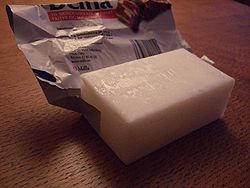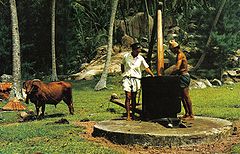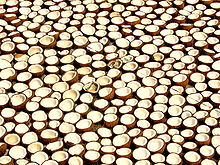
Coconut oil
Background Information
This Schools selection was originally chosen by SOS Children for schools in the developing world without internet access. It is available as a intranet download. All children available for child sponsorship from SOS Children are looked after in a family home by the charity. Read more...

Coconut oil is an edible oil extracted from the kernel or meat of matured coconuts harvested from the coconut palm (Cocos nucifera). Throughout the tropical world, it has provided the primary source of fat in the diets of millions of people for generations. It has various applications in food, medicine, and industry. Because of its stability, it is slow to oxidize and, thus, resistant to rancidity, lasting up to two years owing to the high saturated fat content.
Many health organizations advise against the consumption of high amounts of coconut oil due to its high levels of saturated fat.
Production
Dry process

Coconut oil can be extracted through "dry" or "wet" processing. Dry processing requires the meat to be extracted from the shell and dried using fire, sunlight, or kilns to create copra. The copra is pressed or dissolved with solvents, producing the coconut oil and a high-protein, high-fibre mash. The mash is of poor quality for human consumption and is instead fed to ruminants; there is no process to extract protein from the mash. The preparation and storage of copra often occurs in unhygienic conditions, yielding poor quality oil that requires refining. A portion of the oil extracted from copra is lost to the process of extraction.
Wet process
The all-wet process uses raw coconut rather than dried copra, and the protein in the coconut creates an emulsion of oil and water. The more problematic step is breaking up the emulsion to recover the oil. This used to be done by prolonged boiling, but this produces a discolored oil and is not economical; modern techniques use centrifuges and pre-treatments including cold, heat, acids, salts, enzymes, electrolysis, shock waves, or some combination of them. Despite numerous variations and technologies, wet processing is less viable than dry processing due to a 10-15% lower yield, even compared to the losses due to spoilage and pests with dry processing. Wet processes also require investment of equipment and energy, incurring high capital and operating costs.
Proper harvesting of the coconut (the age of a coconut can be 2 to 20 months when picked) makes a significant difference in the efficacy of the oil-making process. Copra made from immature nuts is more difficult to work with and produces an inferior product with lower yields. Conventional coconut oil uses hexane as a solvent to extract up to 10% more oil than just using rotary mills and expellers. The oil is then refined to remove certain free fatty acids, in order to reduce susceptibility to rancidification. Other processes to increase shelf life include using copra with a moisture content below 6%, keeping the moisture content of the oil below 0.2%, heating the oil to 130–150 °C (266–302 °F) and adding salt or citric acid. Virgin coconut oil (VCO) can be produced from fresh coconut meat, milk or residue. Producing it from the fresh meat involves removing the shell and washing, then either wet-milling or drying the residue and using a screw press to extract the oil. VCO can also be extracted from fresh meat by grating and drying it to a moisture content of 10-12%, then using a manual press to extract the oil. Producing it from coconut milk involves grating the coconut and mixing it with water, then squeezing out the oil. The milk can also be fermented for 36–48 hours, the oil removed, and the cream heated to remove any remaining oil. A third option involves using a centrifuge to separate the oil from the other liquids. Coconut oil can also be extracted from the dry residue left over from the production of coconut milk.
A thousand mature coconuts weighing approximately 1,440 kilograms (3,200 lb) yields around 170 kilograms (370 lb) of copra from which around 70 litres (15 imp gal) of coconut oil can be extracted.
RBD

RBD stands for "refined, bleached, and deodorized." RBD oil is usually made from copra (dried coconut kernel).
The dried copra is placed in a hydraulic press with added heat and the oil is extracted. This yields up practically all the oil present, amounting to more than 60% of the dry weight of the coconut.
This "crude" coconut oil is not suitable for consumption because it contains contaminants and must be refined with further heating and filtering.
Another method for extraction of a "high-quality" coconut oil involves the enzymatic action of alpha-amylase, polygalacturonases, and proteases on diluted coconut paste.
Unlike virgin coconut oil, refined coconut oil has no coconut taste or aroma. RBD oil is used for home cooking, commercial food processing, and cosmetic, industrial, and pharmaceutical purposes.
Hydrogenation
RBD coconut oil can be processed further into partially or fully hydrogenated oil to increase its melting point. Since virgin and RBD coconut oils melt at 24 °C (76 °F), foods containing coconut oil tend to melt in warm climates. A higher melting point is desirable in these warm climates, so the oil is hydrogenated. The melting point of hydrogenated coconut oil is 36–40 °C (97–104 °F).
In the process of hydrogenation, unsaturated fats (monounsaturated and polyunsaturated fatty acids) are combined with hydrogen in a catalytic process to make them more saturated. Coconut oil contains only 6% monounsaturated and 2% polyunsaturated fatty acids. In the partial hydrogenation process, some of these are transformed into trans fatty acids.
Fractionation
Fractionated coconut oil is a fraction of the whole oil, in which the different medium-chain fatty acids are separated for specific uses. Lauric acid, a 12-carbon chain fatty acid, is often removed because of its high value for industrial and medical purposes. The fractionation of coconut oil may be used to make caprylic/ capric triglyceride oil. Medium-chain triglycerides like caprylic/capric triglyceride oil are most frequently used for medical applications, special diets and cosmetics, sometimes also being used as a carrier oil for fragrances.
Figures
The United States Department of Agriculture has published estimated production figures for coconut oil as follows; tabulated years are from October 1 through September 30:
| Year | 2005–06 | 2006–07 | 2007–08 | 2008–09 | 2009–10 | 2010–11 |
| Production | 5.91 | 5.42 | 5.79 | 5.62 | 6.60 | 6.24 |
Coconut oil makes up around 2.5% of world vegetable oil production.
Standards
The World Health Organization's Codex Alimentarius guidelines on food, food production and food safety, published by the Food and Agriculture Organization, includes standards for commercial partners who produce coconut oil for human consumption. The Asian and Pacific Coconut Community (APCC), whose 17 members produce about 90% of the coconut sold commercially, has published its standards for virgin coconut oil (virgin coconut oil is obtained from fresh, mature coconut kernels through means which do not "lead to alteration of the oil").
Composition and comparison
The following table provides information about the composition of coconut oil and how it compares with other vegetable oils.
| Vegetable oils | |||||||
|---|---|---|---|---|---|---|---|
| Type | Saturated fatty acids |
Mono- unsaturated fatty acids |
Polyunsaturated fatty acids | Oleic acid (ω-9) |
Smoke point | ||
| Total poly | linolenic acid (ω-3) |
Linoleic acid (ω-6) |
|||||
| Not hydrogenated | |||||||
| Canola ( rapeseed) | 7.365 | 63.276 | 28.142 | - | - | - | 400 °F (204 °C) |
| Coconut | 91.00 | 6.000 | 3.000 | - | 2 | 6 | 350 °F (177 °C) |
| Corn | 12.948 | 27.576 | 54.677 | 1 | 58 | 28 | 450 °F (232 °C) |
| Cottonseed | 25.900 | 17.800 | 51.900 | 1 | 54 | 19 | 420 °F (216 °C) |
| Flaxseed/Linseed (European) | 6 - 9 | 10 - 22 | 68 - 89 | 56 - 71 | 12 - 18 | 10 - 22 | 225 °F (107 °C) |
| Olive | 14.00 | 72.00 | 14.00 | - | - | - | 380 °F (193 °C) |
| Palm | 49.300 | 37.000 | 9.300 | - | 10 | 40 | 455 °F (235 °C) |
| Peanut | 16.900 | 46.200 | 32.000 | - | 32 | 48 | 437 °F (225 °C) |
| Safflower (>70% linoleic) |
8.00 | 15.00 | 75.00 | - | - | - | 410 °F (210 °C) |
| Safflower (high oleic) |
7.541 | 75.221 | 12.820 | - | - | - | 410 °F (210 °C) |
| Soybean | 15.650 | 22.783 | 57.740 | 7 | 54 | 24 | 460 °F (238 °C) |
| Sunflower (<60% linoleic) |
10.100 | 45.400 | 40.100 | 0.200 | 39.800 | 45.300 | 440 °F (227 °C) |
| Sunflower (>70% oleic) |
9.859 | 83.689 | 3.798 | - | - | - | 440 °F (227 °C) |
| Fully hydrogenated | |||||||
| Cottonseed (hydrog.) | 93.600 | 1.529 | .587 | .287 | |||
| Palm (hydrogenated) | 47.500 | 40.600 | 7.500 | ||||
| Soybean (hydrogen.) | 21.100 | 73.700 | .400 | .096 | |||
| Values as percent (%) by weight of total fat. | |||||||
Health
Many health organizations advise against the consumption of high amounts of coconut oil due to its high levels of saturated fat, including the United States Food and Drug Administration, World Health Organization, International College of Nutrition, the United States Department of Health and Human Services, American Dietetic Association, American Heart Association, British National Health Service, and Dietitians of Canada.
Thomas Brenna, a professor of nutritional sciences at Cornell University, stated that, "Most of the studies involving coconut oil were done with partially hydrogenated coconut oil, which researchers used because they needed to raise the cholesterol levels of their rabbits in order to collect certain data. Virgin coconut oil, which has not been chemically treated, is a different thing in terms of a health risk perspective. And maybe it isn’t so bad for you after all."
Coconut oil contains a large proportion of lauric acid—a saturated fat that raises blood cholesterol levels by increasing the amount of high-density lipoprotein (HDL) cholesterol and low-density lipoprotein (LDL) cholesterol. It is also found in significant amounts in laurel oil, palm kernel oil (not to be confused with palm oil), human and animal breast milk and sebaceous gland secretions. This may create a more favourable blood cholesterol profile, though it is unclear if coconut oil may promote atherosclerosis through other pathways. The effects of coconut oil on the peripheral nervous system in animal models is that it is acutely anti-inflammatory, although chronically neutral. Because much of the saturated fat of coconut oil is in the form of lauric acid, coconut oil may be a better alternative to partially hydrogenated vegetable oil when solid fats are required. In addition, virgin coconut oil is composed mainly of medium-chain triglycerides, which may not carry the same risks as other saturated fats.
Advocacy against coconut and palm oils in the 1970s and 80s due to their perceived danger as a saturated fat caused companies to instead substitute trans fats, unaware of their health-damaging effects.
A repellent made from coconut oil can be used to prevent tungiasis-causing sand fleas from invading the body.
Uses
| Nutritional value per serving | |
|---|---|
| Serving size | 100g |
| Energy | 3,607 kJ (862 kcal) |
| Fat | 100 |
| - saturated | 86.5 |
| - monounsaturated | 5.8 |
| - polyunsaturated | 1.8 |
| Vitamin E | 0.09 mg (1%) |
| Vitamin K | 0.5 μg (0%) |
| Iron | 0.04 mg (0%) |
| Percentages are relative to US recommendations for adults. Source: USDA Nutrient Database |
|
In food
Coconut oil is commonly used in cooking, especially for frying and is a common flavor in many South Asian curries. In recent years, virgin coconut oil has become increasingly popular in natural food circles and with vegans. It was described in a New York Times article as having a "haunting, nutty," flavor that also has a touch of sweetness, which works well in baked goods, pastries, and sautés. Coconut oil is used by movie theatre chains to pop popcorn, adding a large amount of saturated fat in the process. Coconut oil (along with laurel oil and palm kernel oil) contains a large proportion of lauric acid, which is converted to monolaurin in the body, a fat found otherwise only in breast milk. Lauric acid is destroyed by some oil processing methods.
Other culinary uses include replacing solid fats produced through hydrogenation in baked and confectionery goods. Hydrogenated or partially hydrogenated coconut oil is often used in non-dairy creamers, and snack foods including popcorn. Hydrogenated coconut oil is also sold in Australia under the brand-name Copha and is the main ingredient in Australian snacks such as Chocolate crackles and White Christmas.
The smoke point of coconut oil is 177 °C (351 °F).
Industry
Coconut oil has been tested for use as a feedstock for biodiesel to be used as a diesel engine fuel. In this manner, it can be applied to power generators and transport using diesel engines. Since straight coconut oil has a high gelling temperature (22–25 °C), a high viscosity, and a minimum combustion chamber temperature of 500 °C (932 °F) (to avoid polymerization of the fuel), coconut oil is typically transesterified to make biodiesel. Use of B100 (100% biodiesel) is possible only in temperate climates, as the gel point is approximately 10 °C (50 °F). The oil must meet the Weihenstephan standard for pure vegetable oil used as a fuel, otherwise moderate to severe damage from carbonisation and clogging will occur in an unmodified engine.
The Philippines, Vanuatu, Samoa, and several other tropical island countries are using coconut oil as an alternative fuel source to run automobiles, trucks, and buses, and to power generators. Coconut oil is currently used as a fuel for transport in the Philippines. Further research into the oil's potential as a fuel for electricity generation is being carried out in the islands of the Pacific, though to date it appears it is not useful as a fuel source due to the cost of labour and supply constraints.
Coconut oil has been tested for use as an engine lubricant and a transformer oil.
Acids derived from coconut oil can be used as herbicides.
Coconut oil (and derivatives, such as coconut fatty acid) are used as raw materials in the manufacture of surfactants such as cocamidopropyl betaine, cocamide MEA and cocamide DEA.
Personal uses

Coconut oil can be used as a skin moisturizer, helping with dry skin and reduces protein loss when used in hair. Coconut oil can also be used as sexual lubricant, although it can damage latex condoms.
Before the advent of electrical lighting, coconut oil was the primary oil used for illumination in India and was exported as cochin oil.
Coconut oil is an important base ingredient for the manufacture of soap. Soap made with coconut oil tends to be hard, although it retains more water than those made with other oils and therefore increases manufacturer yields. It is more soluble in hard water and salt water than other soaps allowing it to lather more easily. A basic coconut oil soap is clear when melted and a bright white when hardened.


